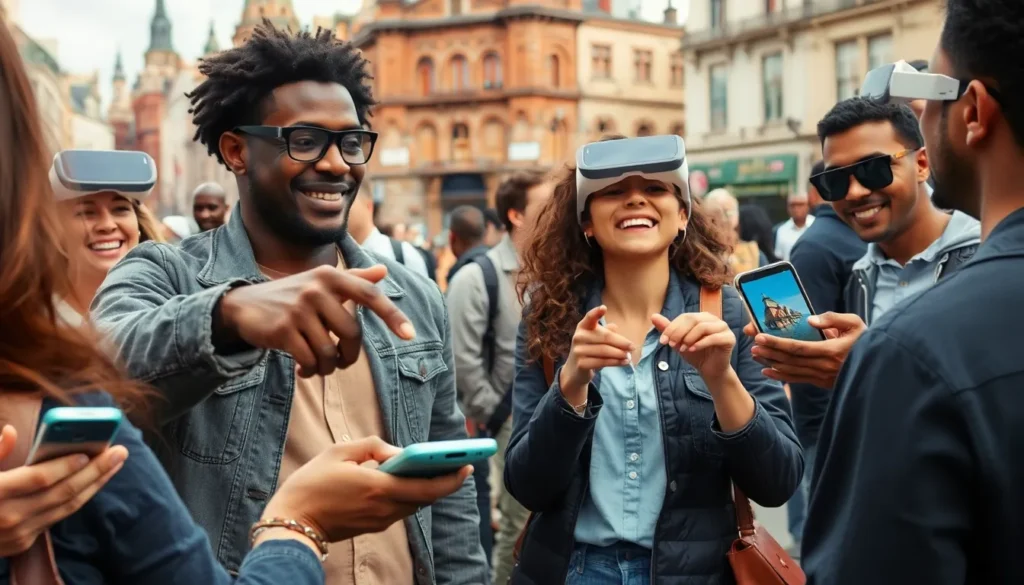Table of Contents
ToggleAugmented reality is no longer just a sci-fi fantasy; it’s a reality that’s reshaping how we interact with the world. From gaming to education, AR is turning everyday experiences into something out of a tech-savvy dream. Imagine walking through your neighborhood and seeing virtual art installations pop up before your eyes or getting real-time information about the historical significance of a landmark with just a glance.
Overview of Augmented Reality Developments
Augmented reality (AR) continues to evolve, integrating seamlessly into diverse sectors. Recent advancements focus on enhancing user engagement through innovative interfaces. Companies such as Magic Leap and Microsoft are pushing boundaries, creating hardware that supports immersive experiences. Users now interact with digital content in ways that were once thought impossible.
Education applications showcase AR’s potential to transform learning environments. Interactive lessons allow students to visualize complex concepts, making learning more effective. For instance, anatomy studies benefit from 3D visualizations, helping students understand human body structures easily.
In the realm of gaming, AR has revolutionized user experiences. Popular titles like Pokémon GO blend the virtual and real world, encouraging outdoor exploration. Beyond entertainment, these games foster social interactions, bridging physical distances among players.
Retail is another area where AR demonstrates significant impact. Virtual try-ons let customers see how clothing or makeup looks on them without physical alterations. This technology increases consumer satisfaction and reduces return rates, leading to improved shopping experiences.
Healthcare also finds utility in AR developments. Surgeons use augmented reality for precise visual overlays during operations, enhancing accuracy and patient outcomes. Medical training programs utilize AR simulations to provide realistic environments for skill development.
Recent trends indicate an increasing focus on cross-platform compatibility. AR applications aim to reach broader audiences by working across various devices. Such advancements further integrate augmented reality into everyday life, providing numerous practical solutions.
Key Technologies Behind Augmented Reality

Key technologies drive the advancements in augmented reality, making immersive experiences more accessible. These technologies include computer vision and depth tracking, two vital components in creating the AR experience.
Computer Vision
Computer vision allows devices to interpret and understand visual information from the world. Algorithms process images and videos, enabling AR systems to identify objects in real-time. This technology recognizes features and coordinates, fostering fluid interactions between virtual content and the physical environment. Accuracy is crucial, as it determines how seamlessly digital elements blend with the real world. Companies such as Google and Apple invest heavily in computer vision, advancing capabilities like facial recognition and image tracking.
Depth Tracking
Depth tracking measures the distance between objects in the environment, enhancing the AR experience. By using sensors and cameras, devices can gauge spatial relationships accurately. This technology creates a sense of scale, allowing virtual objects to occupy a physical space logically. Systems employ techniques like stereo vision and LiDAR to achieve precise depth mapping. For instance, smartphones equipped with LiDAR provide users with improved object placement in AR. Businesses leverage depth tracking to develop applications that need accurate spatial awareness, such as interior design or gaming.
Applications of Augmented Reality
Augmented reality has diverse applications across multiple industries, enhancing how people interact with their environments.
Gaming and Entertainment
AR reshapes the gaming landscape, providing immersive experiences that blend the physical and digital worlds. Players engage with interactive elements overlaid on their surroundings, as seen in Pokémon GO. Popular titles utilize AR features to encourage outdoor exploration, promoting social connections among players. Moreover, entertainment venues implement AR to enhance visitor engagement, offering unique experiences that captivate audiences. Companies continuously develop innovative games that expand AR’s potential, signaling a growing trend in the entertainment sector.
Education and Training
AR transforms traditional learning environments, making education more engaging and interactive. Students can visualize complex concepts, such as anatomy through 3D models, making lessons more effective. Teachers leverage AR applications to create immersive lessons that promote hands-on learning experiences. Additionally, training programs benefit from AR simulations that provide realistic practice opportunities, preparing individuals for real-life scenarios in various fields. The integration of AR in education fosters deeper understanding and retention of knowledge, showcasing its vital role in modern learning approaches.
Healthcare Innovations
In healthcare, AR significantly enhances surgical procedures and medical training. Surgeons benefit from real-time visual overlays, which provide critical information during operations, improving precision and outcomes. Medical professionals also utilize AR simulations for training, allowing them to practice complex procedures in a risk-free environment. Innovative applications aid patient consultations by visualizing treatment options, aiding decision-making processes. As AR technology evolves, its integration into healthcare continues to drive advancements, positively impacting patient care and medical education.
Challenges in Augmented Reality Developments
Augmented reality (AR) faces several challenges that impact its growth and effectiveness. Two significant challenges include technical limitations and user adoption issues.
Technical Limitations
Technical limitations hinder AR’s full potential. Hardware constraints affect performance, requiring powerful devices for optimal experiences. Issues such as latency can disrupt interactions, leading to frustration among users. Moreover, inconsistent access to high-speed internet slows down data processing, creating delays in real-time feedback. On the software side, developers grapple with optimizing applications for various platforms, leading to compatibility issues. It’s essential for advancements in processing power and connectivity to address these limitations effectively.
User Adoption Issues
User adoption issues also play a critical role in AR’s growth. Many consumers find unfamiliarity with the technology a barrier to engagement. Studies indicate that a significant percentage of potential users hesitate to integrate AR into their daily routines. Trust in data privacy remains a concern; users worry about how their information is collected and utilized. Furthermore, a steep learning curve associated with some applications complicates onboarding. Educating users about AR’s practical benefits could enhance acceptance, promoting wider use across different sectors.
Future Trends in Augmented Reality
The future of augmented reality (AR) promises significant advancements, especially in integration and user interaction.
Integration with AI
Integration with artificial intelligence enhances AR functionality. AI algorithms analyze real-world data, delivering personalized content. This combination allows AR applications to respond intelligently to user actions and environmental changes. For instance, virtual assistants become more intuitive by understanding and predicting user preferences. Companies like Facebook and Apple lead the way in developing AI-powered AR features aimed at improving everyday user experiences. Furthermore, predictive analytics in AR systems makes interactions more seamless, as users receive tailored content based on real-time analysis. As these innovations unfold, the relationship between AI and AR will become increasingly vital across sectors.
Enhanced User Experience
Enhanced user experiences come from advanced AR applications. Engaging interfaces and immersive environments significantly improve user interaction. These improvements manifest in sectors like retail, where AR enables virtual try-ons, allowing users to visualize products before purchase. In education, interactive lessons captivate students by bringing learning materials to life. Additionally, travel apps incorporate AR to provide navigational aids and local information in real-time, amplifying exploration experiences. By leveraging user data, AR systems create customized experiences that resonate more deeply, increasing both satisfaction and engagement. Continuous enhancements position AR as a transformative tool that reshapes how people engage with technology daily.
Augmented reality is steadily redefining the way individuals engage with their surroundings. Its applications across gaming, education, healthcare, and retail demonstrate its versatility and potential to enhance everyday experiences. As technology continues to evolve, AR’s integration with artificial intelligence promises to deliver even more personalized and immersive interactions.
While challenges remain, such as technical limitations and user adoption barriers, the ongoing advancements in hardware and software are paving the way for broader acceptance. As companies invest in AR technologies and educate users about its benefits, the future looks bright for this transformative tool. The potential for AR to reshape daily life is immense, making it an exciting area to watch in the coming years.







